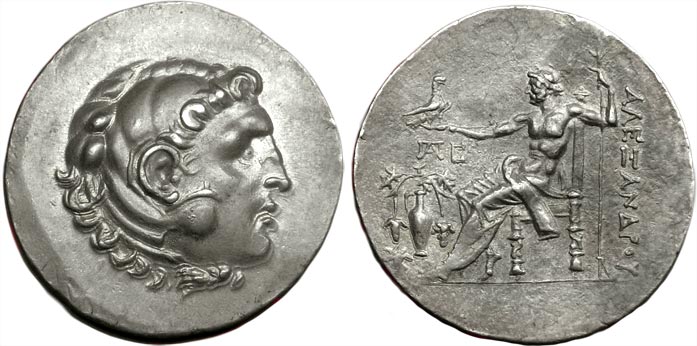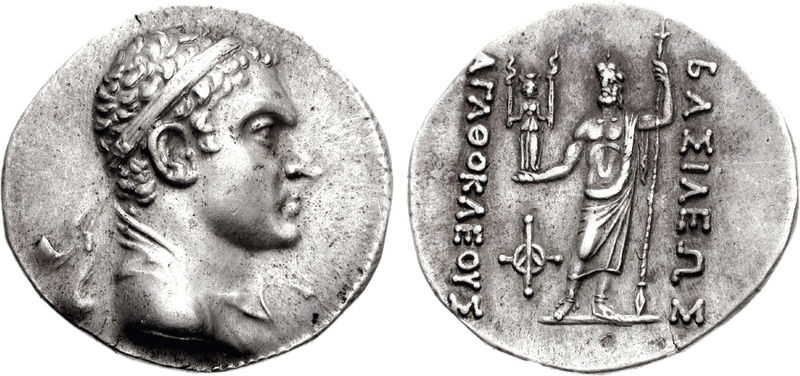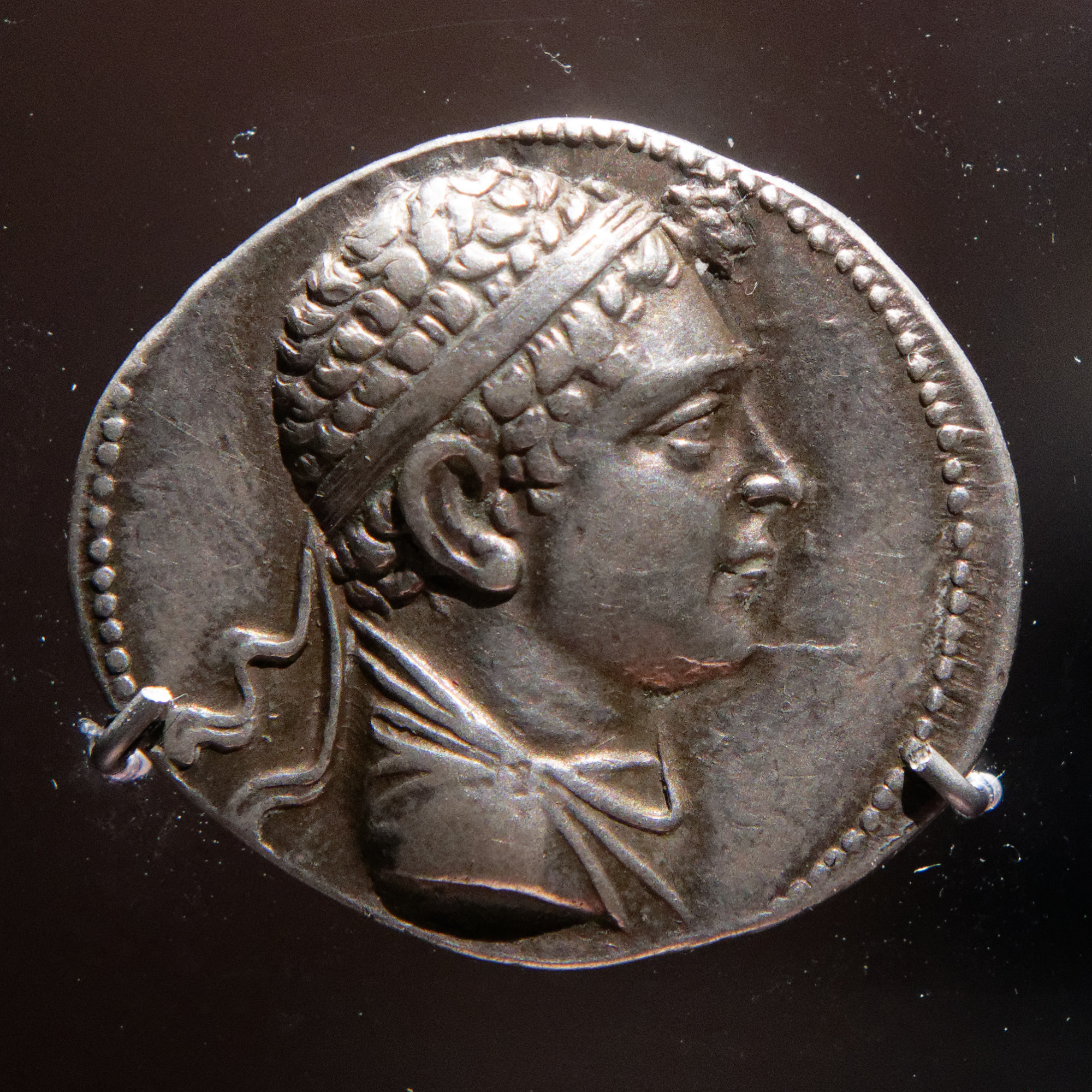|
Euthydemus II
Euthydemus II (Greek: ) was a Greco-Bactrian king who ruled in Bactria in 185-180 BCE. Rule Son of Demetrius I of Bactria, Euthydemus II became king in the 180s BCE, either after his father's death or as a sub-king to him. The style and rare nickel alloys of his coins associates him closely in time with the king Agathocles but their precise relation remains uncertain. Euthydemus is pictured as a boy on his coins and most likely died very young. He was the last Euthydemid ruler of the Greco-Bactrian Kingdom and perhaps related with king Xiutu of Gansu.Lucas, Christopoulos; Dionysian rituals and the Golden Zeus of China pp. http://www.sino-platonic.org/complete/spp326_dionysian_rituals_china.pdf pp.68-112 Coinage File:Dinastia indo-battriana, tetradracma di euthydemos II, 190-185 ac ca.JPG, Portrait of young Euthydemus II. Image:EuthydemusIICoin.jpg, Silver coin of King Euthydemus II. With Greek legend ΒΑΣΙΛΕΩΣ ΕΥΘΥΔΗΜΟΥ, "Of King Euthydemus". File:Euthydemos I ... [...More Info...] [...Related Items...] OR: [Wikipedia] [Google] [Baidu] |
Tetradrachm
The tetradrachm ( grc-gre, τετράδραχμον, tetrádrachmon) was a large silver coin that originated in Ancient Greece. It was nominally equivalent to four Greek drachma, drachmae. Over time the tetradrachm effectively became the standard coin of the Classical Antiquity, Antiquity, spreading well beyond the borders of the Greek World. As a result, tetradrachms were minted in vast quantities by various polities in many weight and finesse standards, though the Athens-derived ''Attic standard'' of about 17.2 grams was the most common. Because of their large size, tetradrachms were often used by various states or rulers to advertise themselves or to deliver political messages. Popularity of the tetradrachm outlived the political independence of the Greeks and it remained in wide circulation in the Mediterranean up until Crisis of the Third Century, while debased varieties persisted in India and Central Asia into early Middle Ages. Due to their often high artistic level tetra ... [...More Info...] [...Related Items...] OR: [Wikipedia] [Google] [Baidu] |
Agathocles Of Bactria
Agathocles I Dicaeus ( grc, Ἀγαθοκλῆς Δικαῖος, Agathoklēs Dikaios, the epithet means "the just") was a Greco-Bactrian/Indo-Greek king, who reigned between around 190 and 180 BC, likely of the dynasty of Diodotus I, due to his commemoration of Antiochus Nicator. Accounts and discovery There is a near-complete lack of written sources except an extensive coinage. Agathocles was first discovered by Johann Martin Honigberger in 1834, with hordes of coins being discovered at a rapid pace. No sooner had Desiré-Raoul Rochette held him to be the founder of the Bactrian dynasty than he was rejected by Christian Lassen, who felt that Agathocles was a contemporary of Demetrius and Eucratides I. Biography Agathocles' father may have been Diodotus II, and he would therefore have been illegitimate. Agathocles ruled c. 185 BC and was probably the immediate successor of Pantaleon; he was a contemporaneous relative (maybe, son) of Demetrius I of Bactria, Demetrius I, who ... [...More Info...] [...Related Items...] OR: [Wikipedia] [Google] [Baidu] |
William Woodthorpe Tarn
Sir William Woodthorpe Tarn (26 February 1869 – 7 November 1957) was a British classics, classical scholar and a writer. He wrote extensively on the Hellenistic world, particularly on Alexander the Great, Alexander the Great's empire and its successor states. Life William Woodthorpe Tarn was born in London on the 26 of February 1869, eldest of two sons and one daughter of William Tarn (b. 1841/2), a silk merchant, and Frances Arthy (b. 1843/4). He studied at Eton College, where he was school captain and a king's scholar, graduating in 1888. He studied at Trinity College, Cambridge with Henry Jackson (classicist), Henry Jackson, sparking a lifelong interest in Greek philosophy. He then studied law at the Inner Temple, becoming a chancery barrister in 1894. In 1896 he married Flora Macdonald (d. 1937). He had one daughter, Otta, for whom he wrote a fairy story, ''The Treasure of the Isle of Mist'' (1919). Following the long illness of Flora, Tarn had a breakdown and retired from ... [...More Info...] [...Related Items...] OR: [Wikipedia] [Google] [Baidu] |
Kushan Empire
The Kushan Empire ( grc, Βασιλεία Κοσσανῶν; xbc, Κυϸανο, ; sa, कुषाण वंश; Brahmi: , '; BHS: ; xpr, 𐭊𐭅𐭔𐭍 𐭇𐭔𐭕𐭓, ; zh, 貴霜 ) was a syncretic empire, formed by the Yuezhi, in the Bactrian territories in the early 1st century. It spread to encompass much of modern-day territory of, Afghanistan, Pakistan, Uzbekistan, and northern India, at least as far as Saketa and Sarnath near Varanasi (Benares), where inscriptions have been found dating to the era of the Kushan Emperor Kanishka the Great. The Kushans were most probably one of five branches of the Yuezhi confederation, an Indo-European nomadic people of possible Tocharian origin, who migrated from northwestern China (Xinjiang and Gansu) and settled in ancient Bactria. The founder of the dynasty, Kujula Kadphises, followed Greek religious ideas and iconography after the Greco-Bactrian tradition, and being a follower of Shaivism. The Kushans in general were ... [...More Info...] [...Related Items...] OR: [Wikipedia] [Google] [Baidu] |
Indo-Parthian Kingdom
The Indo-Parthian Kingdom was a Parthian kingdom founded by Gondophares, and active from 19 CE to c. 226 CE. At their zenith, they ruled an area covering parts of eastern Iran, various parts of Afghanistan and the northwest regions of the Indian subcontinent (most of modern Pakistan and parts of northwestern India). The rulers may have been members of the House of Suren, and the kingdom has even been called the "Suren Kingdom" by some authors. The kingdom was founded in 19 when the governor of Drangiana (Sakastan) Gondophares declared independence from the Parthian Empire. He would later make expeditions to the east, conquering territory from the Indo-Scythians and Indo-Greeks, thus transforming his kingdom into an empire. The domains of the Indo-Parthians were greatly reduced following the invasions of the Kushans in the second half of the 1st. century. They managed to retain control of Sakastan, until its conquest by the Sasanian Empire in c. 224/5. In Baluchistan, the Para ... [...More Info...] [...Related Items...] OR: [Wikipedia] [Google] [Baidu] |
Indo-Scythians
Indo-Scythians (also called Indo-Sakas) were a group of nomadic Iranian peoples of Scythian origin who migrated from Central Asia southward into modern day Pakistan and Northwestern India from the middle of the 2nd century BCE to the 4th century CE. The first Saka king of India was Maues/Moga (1st century BCE) who established Saka power in Gandhara, Pakistan and the Indus Valley. The Indo-Scythians extended their supremacy over north-western India, conquering the Indo-Greeks and other local kingdoms. The Indo-Scythians were apparently subjugated by the Kushan Empire, by either Kujula Kadphises or Kanishka. Yet the Saka continued to govern as satrapies, forming the Northern Satraps and Western Satraps. The power of the Saka rulers started to decline in the 2nd century CE after the Indo-Scythians were defeated by the Satavahana emperor Gautamiputra Satakarni. Indo-Scythian rule in the northwestern Indian subcontinent ceased when the last Western Satrap Rudrasimha III was defea ... [...More Info...] [...Related Items...] OR: [Wikipedia] [Google] [Baidu] |
Greco-Buddhism
Greco-Buddhism, or Graeco-Buddhism, is the cultural syncretism between Hellenistic culture and Buddhism, which developed between the fourth century BC and the fifth century AD in Gandhara, in present-day north-western Pakistan and parts of north-east Afghanistan. It was a cultural consequence of a long chain of interactions begun by Greek forays into India from the time of Alexander the Great. A few years after Alexander's death, the Easternmost fringes of the empire of his general Seleucus were lost in a war with the Mauryan Empire, under the reign of Chandragupta Maurya. The Mauryan Emperor Ashoka would convert to Buddhism and spread the religious philosophy throughout his domain, as recorded in the Edicts of Ashoka. This spread to the Greco-Bactrian kingdom, which itself seceded from the Seleucid empire. Within its borders, the Greek fondness for statuary produced the first statues of the Buddha, leading ultimately to the modern tradition. Following the collapse of the Maur ... [...More Info...] [...Related Items...] OR: [Wikipedia] [Google] [Baidu] |
Seleucid Empire
The Seleucid Empire (; grc, Βασιλεία τῶν Σελευκιδῶν, ''Basileía tōn Seleukidōn'') was a Greek state in West Asia that existed during the Hellenistic period from 312 BC to 63 BC. The Seleucid Empire was founded by the Macedonian general Seleucus I Nicator, following the division of the Macedonian Empire originally founded by Alexander the Great. After receiving the Mesopotamian region of Babylonia in 321 BC, Seleucus I began expanding his dominions to include the Near Eastern territories that encompass modern-day Iraq, Iran, Afghanistan, Syria, all of which had been under Macedonian control after the fall of the former Persian Achaemenid Empire. At the Seleucid Empire's height, it had consisted of territory that had covered Anatolia, Persia, the Levant, and what are now modern Iraq, Kuwait, Afghanistan, and parts of Turkmenistan. The Seleucid Empire was a major center of Hellenistic culture. Greek customs and language were privileged; the wide varie ... [...More Info...] [...Related Items...] OR: [Wikipedia] [Google] [Baidu] |
Bactria
Bactria (; Bactrian: , ), or Bactriana, was an ancient region in Central Asia in Amu Darya's middle stream, stretching north of the Hindu Kush, west of the Pamirs and south of the Gissar range, covering the northern part of Afghanistan, southwestern Tajikistan and southeastern Uzbekistan. Called "beautiful Bactria, crowned with flags" by the Avesta, the region is one of the sixteen perfect Iranian lands that the supreme deity Ahura Mazda had created. One of the early centres of Zoroastrianism and capital of the legendary Kayanian kings of Iran, Bactria is mentioned in the Behistun Inscription of Darius the Great as one of the satrapies of the Achaemenid Empire; it was a special satrapy and was ruled by a crown prince or an intended heir. Bactria was the centre of Iranian resistance against the Macedonian invaders after the fall of the Achaemenid Empire in the 4th century BC, but eventually fell to Alexander the Great. After the death of Alexander, Bactria was annexed by ... [...More Info...] [...Related Items...] OR: [Wikipedia] [Google] [Baidu] |
Nurek Dam
The Nurek Dam (russian: Нурекская ГЭС; Tajik: Нерӯгоҳи обии Норак, ''Nerūgohi obii Norak'', Tajik for Nurek Hydro-electric Station) is an earth-fill embankment dam on the Vakhsh River in Tajikistan. Its primary purpose is hydroelectric power generation and its power station has an installed capacity of 3,015 MW. Construction of the dam began in 1961 and the power station's first generator was commissioned in 1972. The last generator was commissioned in 1979 and the entire project was completed in 1980 when Tajikistan was still a republic within the Soviet Union, becoming the tallest dam in the world at the time. At , it is currently the second tallest man-made dam in the world, after being surpassed by Jinping-I Dam in 2013. The Rogun Dam, also along the Vakhsh in Tajikistan, may exceed it in size when completed. Construction The Nurek Dam was constructed by the Soviet Union between the years 1961 and 1980. It is uniquely constructed, with a centr ... [...More Info...] [...Related Items...] OR: [Wikipedia] [Google] [Baidu] |
Greco-Bactrian Kingdom
The Bactrian Kingdom, known to historians as the Greco-Bactrian Kingdom or simply Greco-Bactria, was a Hellenistic period, Hellenistic-era Hellenistic Greece, Greek state, and along with the Indo-Greek Kingdom, the easternmost part of the Hellenistic world in Central Asia and the Indian subcontinent, Indian Subcontinent from its founding in 256 BC by Diodotus I, Diodotus I Soter to its fall BC under the reign of Heliocles I. It covered much of present-day Afghanistan, Uzbekistan, Tajikistan and Turkmenistan, and at its zenith, parts of Iran and Pakistan. An extension further east with military campaigns may have reached central Gansu, Gansu province in China. Bactria was ruled by the Diodotid dynasty and rival Euthydemid dynasty. The capitals of Ai-Khanoum, Ai-Khanum and Balkh, Bactra were among the largest and richest of antiquity - Bactria itself was known as the ‘''land of a thousand golden cities’''. The Indo-Greek Kingdom, Indo-Greek Kingdoms, as Bactrian successor states ... [...More Info...] [...Related Items...] OR: [Wikipedia] [Google] [Baidu] |
Greek Language
Greek ( el, label=Modern Greek, Ελληνικά, Elliniká, ; grc, Ἑλληνική, Hellēnikḗ) is an independent branch of the Indo-European family of languages, native to Greece, Cyprus, southern Italy (Calabria and Salento), southern Albania, and other regions of the Balkans, the Black Sea coast, Asia Minor, and the Eastern Mediterranean. It has the longest documented history of any Indo-European language, spanning at least 3,400 years of written records. Its writing system is the Greek alphabet, which has been used for approximately 2,800 years; previously, Greek was recorded in writing systems such as Linear B and the Cypriot syllabary. The alphabet arose from the Phoenician script and was in turn the basis of the Latin, Cyrillic, Armenian, Coptic, Gothic, and many other writing systems. The Greek language holds a very important place in the history of the Western world. Beginning with the epics of Homer, ancient Greek literature includes many works of lasting impo ... [...More Info...] [...Related Items...] OR: [Wikipedia] [Google] [Baidu] |




.jpeg/1200px-Gandhara_Buddha_(tnm).jpeg)




